Understanding Consumer Decision-Making in B2C and B2B Marketing
VerifiedAdded on 2023/06/11
|12
|4000
|321
Report
AI Summary
This report provides a comprehensive analysis of consumer decision-making processes in both Business-to-Consumer (B2C) and Business-to-Business (B2B) contexts, using Amazon plc as a case study. It explores the stages of the consumer decision-making journey, highlighting the importance for marketers to map the path to purchase and understand consumer behavior. The report compares and contrasts the key differences in decision-making between B2C and B2B, providing specific examples. It also evaluates various market research approaches and methods used to understand decision-making in both contexts. Furthermore, the report assesses how marketers can influence different stages of the decision-making process in B2C and B2B, offering practical examples. The analysis incorporates models of consumer decision-making, such as the economical, passive, and cognitive views, and levels of consumer decision-making, including extensive, limited, and routine problem-solving. The report concludes by emphasizing the significance of understanding consumer needs and desires in developing effective marketing strategies.

17042 unit 37
Paraphrase This Document
Need a fresh take? Get an instant paraphrase of this document with our AI Paraphraser

Contents
INTRODUCTION...........................................................................................................................1
TASK 1............................................................................................................................................1
P1 Explain and analyse the stages of the consumer decision-making journey for a given
product/service.......................................................................................................................1
P2 Explain why it is important for marketers to map a path to purchase and understand
consumer decision-making.....................................................................................................2
TASK 2............................................................................................................................................3
P3 Compare and contrast the key differences of the decision-making process in the context of
B2C and B2B, providing specific examples...........................................................................3
P4 Evaluate the different approaches to market research and methods of research used for
understanding the decision-making process in both B2C and B2B contexts.........................5
TASK 3............................................................................................................................................6
P5 Evaluate how marketers can influence the different stages of the decision-making process
of B2C and B2B, giving specific examples............................................................................6
CONCLUSION................................................................................................................................7
References:.......................................................................................................................................8
INTRODUCTION...........................................................................................................................1
TASK 1............................................................................................................................................1
P1 Explain and analyse the stages of the consumer decision-making journey for a given
product/service.......................................................................................................................1
P2 Explain why it is important for marketers to map a path to purchase and understand
consumer decision-making.....................................................................................................2
TASK 2............................................................................................................................................3
P3 Compare and contrast the key differences of the decision-making process in the context of
B2C and B2B, providing specific examples...........................................................................3
P4 Evaluate the different approaches to market research and methods of research used for
understanding the decision-making process in both B2C and B2B contexts.........................5
TASK 3............................................................................................................................................6
P5 Evaluate how marketers can influence the different stages of the decision-making process
of B2C and B2B, giving specific examples............................................................................6
CONCLUSION................................................................................................................................7
References:.......................................................................................................................................8

INTRODUCTION
Consumers are consider as the most important part of every organisation as all the
business activities revolve around the consumers. Hence, it is found as essential to understand
the elements which affect the decision related to the buying any product (Alfian and et. al.,
2019). The chosen organisation for this report is Amazon plc which is an American multinational
technology company. This company is majorly focusing on the e-commercialism, analogue
moving, cloud computing and artificial intelligence. This report include the stages of consumer
decision making process, importance of understanding the consumer decision making, difference
in decision making process in B2C and B2B. In addition to this, it also deals with the several
approaches and methods of market research and the influence of marketers on several stages of
decision making process.
TASK 1
P1 Explain and analyse the stages of the consumer decision-making journey for a given
product/service.
Marketing studies has a wide concept and the consumer decision making procedure is
just a portion of it which have been used by the marketers of organisation for the aim of trailing
or distinguishing the entire procedure of decision making of consumers from start to last. Below
mentioned are the several stages of decision making procedure of consumers: Problem Recognition: It is the stage under which the recognition of needs and demand of
customers have been done. The consumer look for the factor which is missing and try to
make efforts for the purpose of getting hindmost to getting normal. In the context of
Amazon, people were facing the difficulty of delay in delivery of their orders. This
problem have been recognised by Amazon and the management introduce the Prime
Membership (Aluri, Price and McIntyre 2019). It provide the service of delivering the
orders within 24 hours. Information Search: At this level, information have been collected on the basis of
recommendation and prior experiences of customers. Consumer look for the risk
management by making decision on the basis of analysing the merits and demerits of
products. The customers have to face some extra fees for Prime membership but it also
provide the benefit of fastest delivery.
1
Consumers are consider as the most important part of every organisation as all the
business activities revolve around the consumers. Hence, it is found as essential to understand
the elements which affect the decision related to the buying any product (Alfian and et. al.,
2019). The chosen organisation for this report is Amazon plc which is an American multinational
technology company. This company is majorly focusing on the e-commercialism, analogue
moving, cloud computing and artificial intelligence. This report include the stages of consumer
decision making process, importance of understanding the consumer decision making, difference
in decision making process in B2C and B2B. In addition to this, it also deals with the several
approaches and methods of market research and the influence of marketers on several stages of
decision making process.
TASK 1
P1 Explain and analyse the stages of the consumer decision-making journey for a given
product/service.
Marketing studies has a wide concept and the consumer decision making procedure is
just a portion of it which have been used by the marketers of organisation for the aim of trailing
or distinguishing the entire procedure of decision making of consumers from start to last. Below
mentioned are the several stages of decision making procedure of consumers: Problem Recognition: It is the stage under which the recognition of needs and demand of
customers have been done. The consumer look for the factor which is missing and try to
make efforts for the purpose of getting hindmost to getting normal. In the context of
Amazon, people were facing the difficulty of delay in delivery of their orders. This
problem have been recognised by Amazon and the management introduce the Prime
Membership (Aluri, Price and McIntyre 2019). It provide the service of delivering the
orders within 24 hours. Information Search: At this level, information have been collected on the basis of
recommendation and prior experiences of customers. Consumer look for the risk
management by making decision on the basis of analysing the merits and demerits of
products. The customers have to face some extra fees for Prime membership but it also
provide the benefit of fastest delivery.
1
⊘ This is a preview!⊘
Do you want full access?
Subscribe today to unlock all pages.

Trusted by 1+ million students worldwide

Evaluation of Alternative: While making decisions related to purchase, the consumers
look for the alternatives of particular products which are available in the market. This
step involve the comparison of products on the basis of reviews and prices and then select
the best suitable products. Employees of Amazon understand the evaluation of their
customers and recommand the alternatives to consumers by its own.
Purchase: At this level, the customer make the decision related to purchase of product in
which they are interested. This decision is made on the basis of assessment of
experiences, advertisement, emotions or marketing (Bawack, Wamba and Carillo, 2021).
Post Purchase Satisfaction (Reviews): It is the last and most important stage as it
summarize the level of satisfaction of consumers. At this level, all the feedbacks are
being studied and then changes are being made in the products. Amazon is also working
on the evaluation of feedbacks and they try to improve the quality of products.
Models of Consumer Decision Making An Economical View or Model: It is also manageable to create a number of wording
related to the behaviour purchaser on the basis of price effect, income effect, and
substitution effect using this model. While these forecasts are valuable, there are several
concerns with the assumption of rationality in buyer behavior. The Passive View or Model: The passive model has been chastised for failing to adopt a
pragmatic view of customers. It is claimed that in a purchasing situation, the consumer
will engage in a decision-making process in which he will seek product information,
analyse all alternative brands, and finally select the brand that will offer him with the
most satisfaction. Emotions or moods can also influence a consumer's purchase decision.
As a result, it's a mistake to think that customers will be passive when making purchases.
2
look for the alternatives of particular products which are available in the market. This
step involve the comparison of products on the basis of reviews and prices and then select
the best suitable products. Employees of Amazon understand the evaluation of their
customers and recommand the alternatives to consumers by its own.
Purchase: At this level, the customer make the decision related to purchase of product in
which they are interested. This decision is made on the basis of assessment of
experiences, advertisement, emotions or marketing (Bawack, Wamba and Carillo, 2021).
Post Purchase Satisfaction (Reviews): It is the last and most important stage as it
summarize the level of satisfaction of consumers. At this level, all the feedbacks are
being studied and then changes are being made in the products. Amazon is also working
on the evaluation of feedbacks and they try to improve the quality of products.
Models of Consumer Decision Making An Economical View or Model: It is also manageable to create a number of wording
related to the behaviour purchaser on the basis of price effect, income effect, and
substitution effect using this model. While these forecasts are valuable, there are several
concerns with the assumption of rationality in buyer behavior. The Passive View or Model: The passive model has been chastised for failing to adopt a
pragmatic view of customers. It is claimed that in a purchasing situation, the consumer
will engage in a decision-making process in which he will seek product information,
analyse all alternative brands, and finally select the brand that will offer him with the
most satisfaction. Emotions or moods can also influence a consumer's purchase decision.
As a result, it's a mistake to think that customers will be passive when making purchases.
2
Paraphrase This Document
Need a fresh take? Get an instant paraphrase of this document with our AI Paraphraser
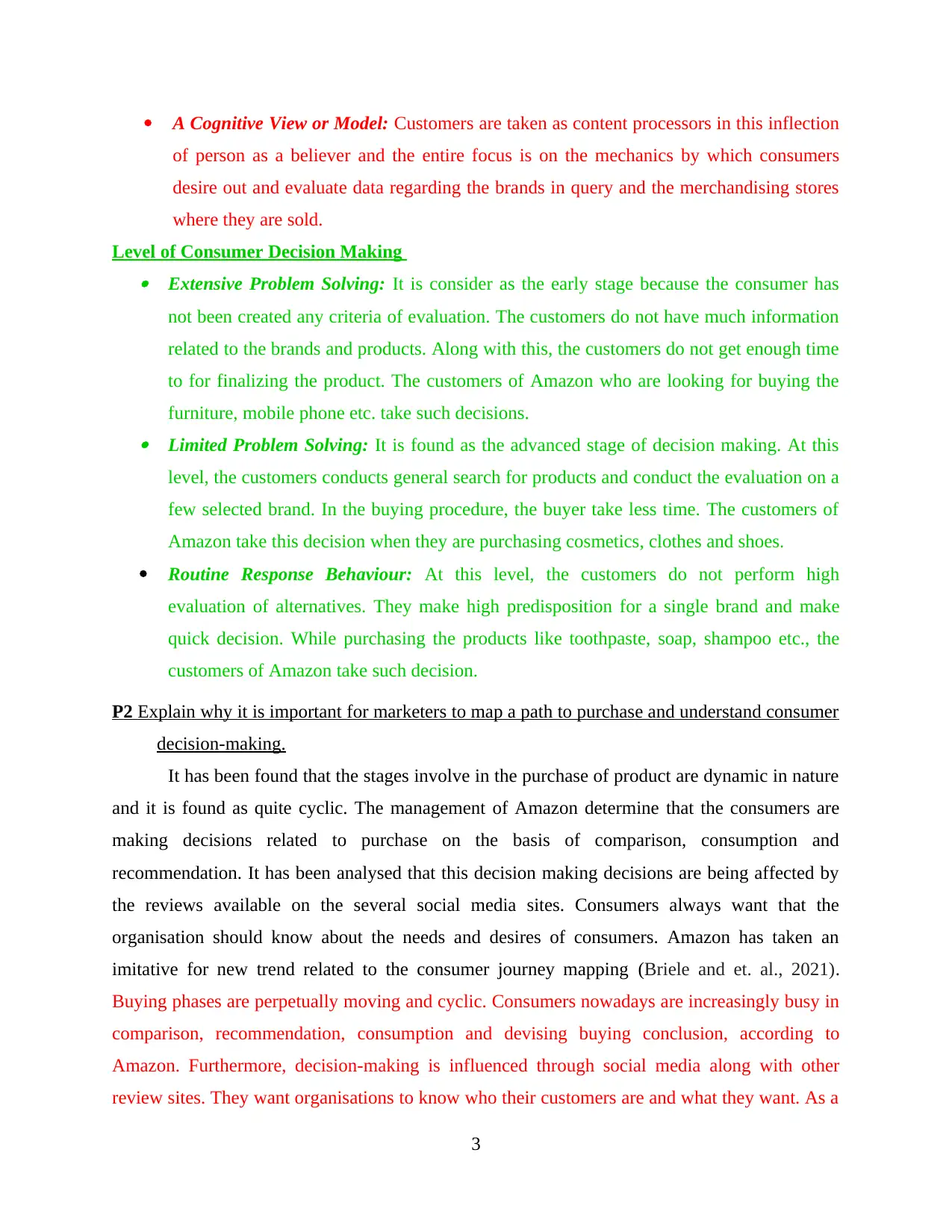
A Cognitive View or Model: Customers are taken as content processors in this inflection
of person as a believer and the entire focus is on the mechanics by which consumers
desire out and evaluate data regarding the brands in query and the merchandising stores
where they are sold.
Level of Consumer Decision Making Extensive Problem Solving: It is consider as the early stage because the consumer has
not been created any criteria of evaluation. The customers do not have much information
related to the brands and products. Along with this, the customers do not get enough time
to for finalizing the product. The customers of Amazon who are looking for buying the
furniture, mobile phone etc. take such decisions. Limited Problem Solving: It is found as the advanced stage of decision making. At this
level, the customers conducts general search for products and conduct the evaluation on a
few selected brand. In the buying procedure, the buyer take less time. The customers of
Amazon take this decision when they are purchasing cosmetics, clothes and shoes.
Routine Response Behaviour: At this level, the customers do not perform high
evaluation of alternatives. They make high predisposition for a single brand and make
quick decision. While purchasing the products like toothpaste, soap, shampoo etc., the
customers of Amazon take such decision.
P2 Explain why it is important for marketers to map a path to purchase and understand consumer
decision-making.
It has been found that the stages involve in the purchase of product are dynamic in nature
and it is found as quite cyclic. The management of Amazon determine that the consumers are
making decisions related to purchase on the basis of comparison, consumption and
recommendation. It has been analysed that this decision making decisions are being affected by
the reviews available on the several social media sites. Consumers always want that the
organisation should know about the needs and desires of consumers. Amazon has taken an
imitative for new trend related to the consumer journey mapping (Briele and et. al., 2021).
Buying phases are perpetually moving and cyclic. Consumers nowadays are increasingly busy in
comparison, recommendation, consumption and devising buying conclusion, according to
Amazon. Furthermore, decision-making is influenced through social media along with other
review sites. They want organisations to know who their customers are and what they want. As a
3
of person as a believer and the entire focus is on the mechanics by which consumers
desire out and evaluate data regarding the brands in query and the merchandising stores
where they are sold.
Level of Consumer Decision Making Extensive Problem Solving: It is consider as the early stage because the consumer has
not been created any criteria of evaluation. The customers do not have much information
related to the brands and products. Along with this, the customers do not get enough time
to for finalizing the product. The customers of Amazon who are looking for buying the
furniture, mobile phone etc. take such decisions. Limited Problem Solving: It is found as the advanced stage of decision making. At this
level, the customers conducts general search for products and conduct the evaluation on a
few selected brand. In the buying procedure, the buyer take less time. The customers of
Amazon take this decision when they are purchasing cosmetics, clothes and shoes.
Routine Response Behaviour: At this level, the customers do not perform high
evaluation of alternatives. They make high predisposition for a single brand and make
quick decision. While purchasing the products like toothpaste, soap, shampoo etc., the
customers of Amazon take such decision.
P2 Explain why it is important for marketers to map a path to purchase and understand consumer
decision-making.
It has been found that the stages involve in the purchase of product are dynamic in nature
and it is found as quite cyclic. The management of Amazon determine that the consumers are
making decisions related to purchase on the basis of comparison, consumption and
recommendation. It has been analysed that this decision making decisions are being affected by
the reviews available on the several social media sites. Consumers always want that the
organisation should know about the needs and desires of consumers. Amazon has taken an
imitative for new trend related to the consumer journey mapping (Briele and et. al., 2021).
Buying phases are perpetually moving and cyclic. Consumers nowadays are increasingly busy in
comparison, recommendation, consumption and devising buying conclusion, according to
Amazon. Furthermore, decision-making is influenced through social media along with other
review sites. They want organisations to know who their customers are and what they want. As a
3
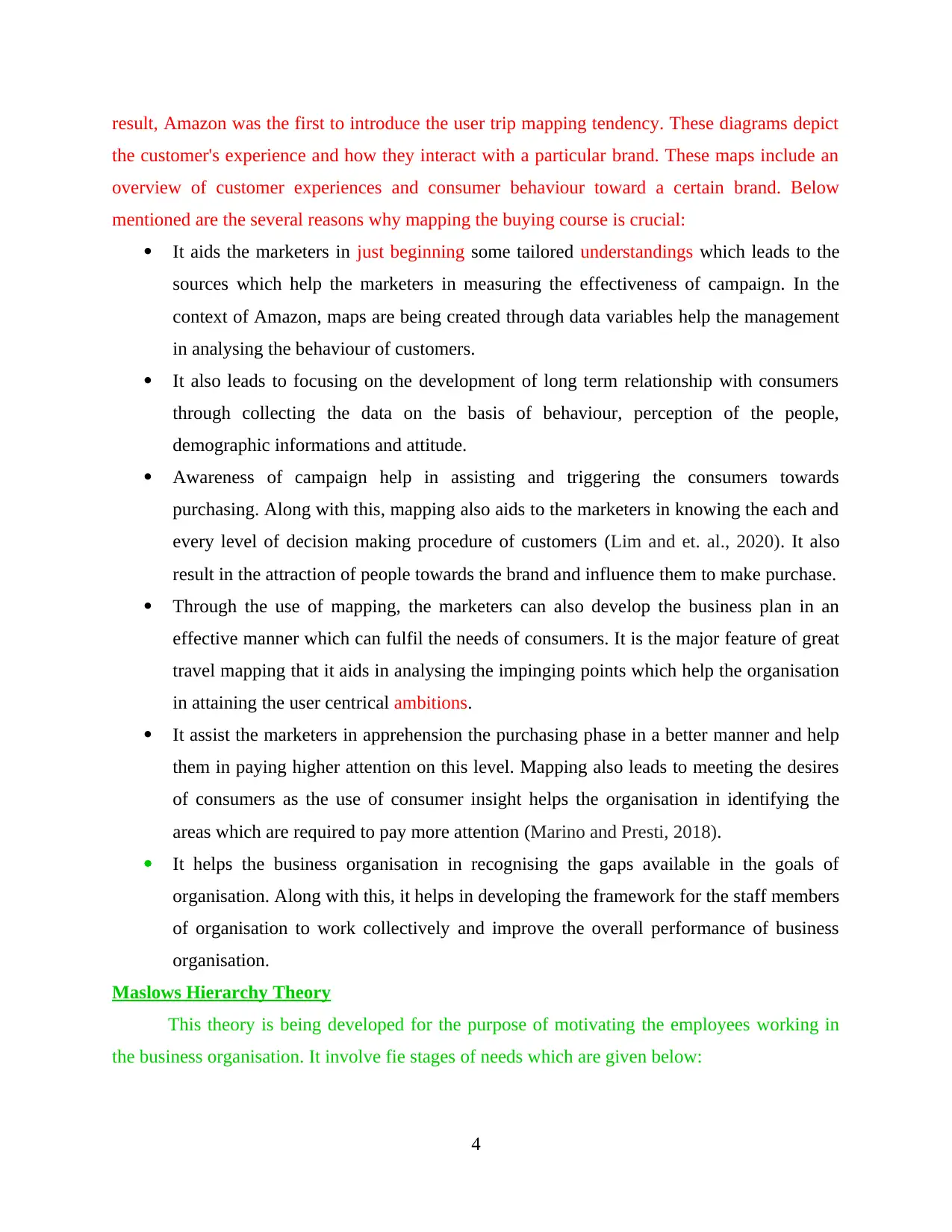
result, Amazon was the first to introduce the user trip mapping tendency. These diagrams depict
the customer's experience and how they interact with a particular brand. These maps include an
overview of customer experiences and consumer behaviour toward a certain brand. Below
mentioned are the several reasons why mapping the buying course is crucial:
It aids the marketers in just beginning some tailored understandings which leads to the
sources which help the marketers in measuring the effectiveness of campaign. In the
context of Amazon, maps are being created through data variables help the management
in analysing the behaviour of customers.
It also leads to focusing on the development of long term relationship with consumers
through collecting the data on the basis of behaviour, perception of the people,
demographic informations and attitude.
Awareness of campaign help in assisting and triggering the consumers towards
purchasing. Along with this, mapping also aids to the marketers in knowing the each and
every level of decision making procedure of customers (Lim and et. al., 2020). It also
result in the attraction of people towards the brand and influence them to make purchase.
Through the use of mapping, the marketers can also develop the business plan in an
effective manner which can fulfil the needs of consumers. It is the major feature of great
travel mapping that it aids in analysing the impinging points which help the organisation
in attaining the user centrical ambitions.
It assist the marketers in apprehension the purchasing phase in a better manner and help
them in paying higher attention on this level. Mapping also leads to meeting the desires
of consumers as the use of consumer insight helps the organisation in identifying the
areas which are required to pay more attention (Marino and Presti, 2018).
It helps the business organisation in recognising the gaps available in the goals of
organisation. Along with this, it helps in developing the framework for the staff members
of organisation to work collectively and improve the overall performance of business
organisation.
Maslows Hierarchy Theory
This theory is being developed for the purpose of motivating the employees working in
the business organisation. It involve fie stages of needs which are given below:
4
the customer's experience and how they interact with a particular brand. These maps include an
overview of customer experiences and consumer behaviour toward a certain brand. Below
mentioned are the several reasons why mapping the buying course is crucial:
It aids the marketers in just beginning some tailored understandings which leads to the
sources which help the marketers in measuring the effectiveness of campaign. In the
context of Amazon, maps are being created through data variables help the management
in analysing the behaviour of customers.
It also leads to focusing on the development of long term relationship with consumers
through collecting the data on the basis of behaviour, perception of the people,
demographic informations and attitude.
Awareness of campaign help in assisting and triggering the consumers towards
purchasing. Along with this, mapping also aids to the marketers in knowing the each and
every level of decision making procedure of customers (Lim and et. al., 2020). It also
result in the attraction of people towards the brand and influence them to make purchase.
Through the use of mapping, the marketers can also develop the business plan in an
effective manner which can fulfil the needs of consumers. It is the major feature of great
travel mapping that it aids in analysing the impinging points which help the organisation
in attaining the user centrical ambitions.
It assist the marketers in apprehension the purchasing phase in a better manner and help
them in paying higher attention on this level. Mapping also leads to meeting the desires
of consumers as the use of consumer insight helps the organisation in identifying the
areas which are required to pay more attention (Marino and Presti, 2018).
It helps the business organisation in recognising the gaps available in the goals of
organisation. Along with this, it helps in developing the framework for the staff members
of organisation to work collectively and improve the overall performance of business
organisation.
Maslows Hierarchy Theory
This theory is being developed for the purpose of motivating the employees working in
the business organisation. It involve fie stages of needs which are given below:
4
⊘ This is a preview!⊘
Do you want full access?
Subscribe today to unlock all pages.

Trusted by 1+ million students worldwide
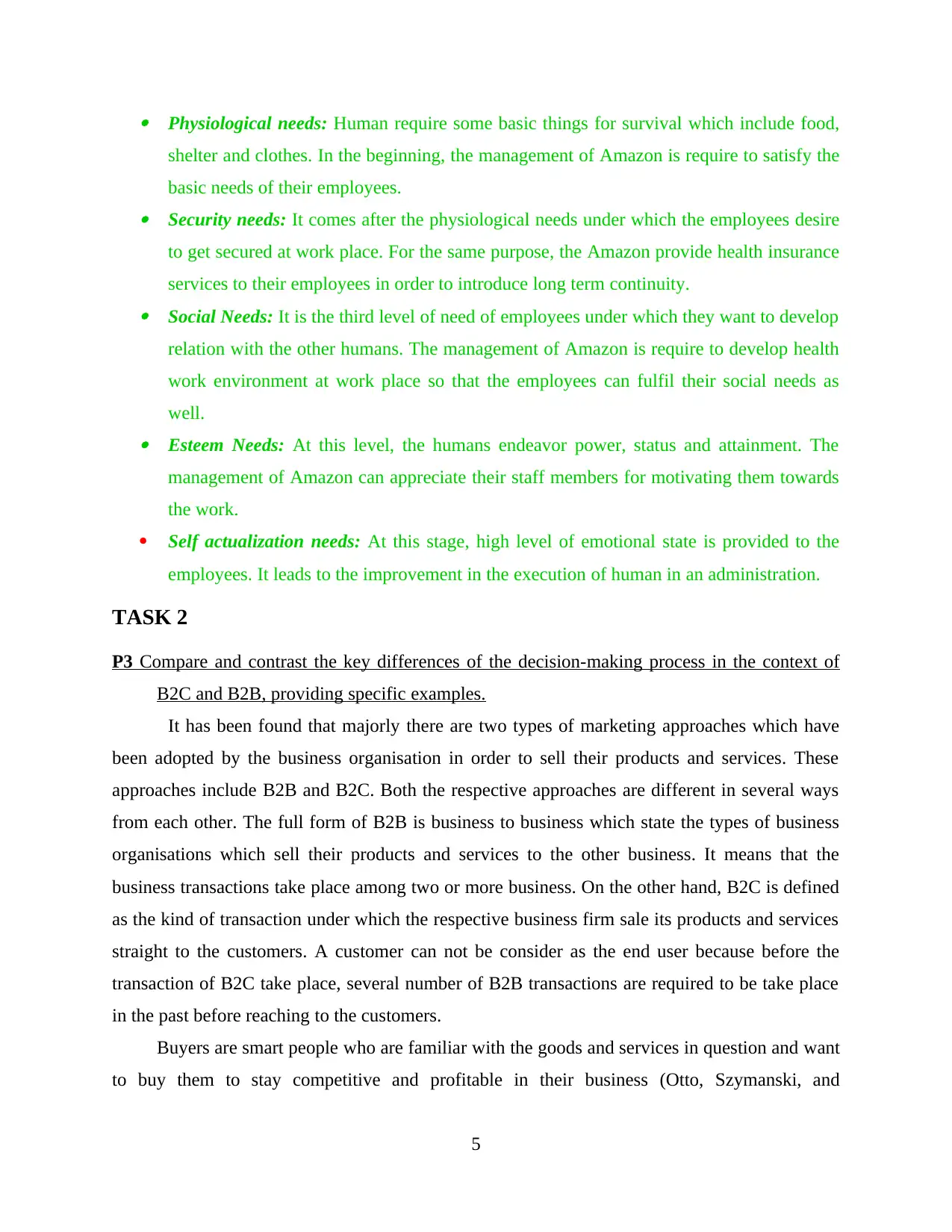
Physiological needs: Human require some basic things for survival which include food,
shelter and clothes. In the beginning, the management of Amazon is require to satisfy the
basic needs of their employees. Security needs: It comes after the physiological needs under which the employees desire
to get secured at work place. For the same purpose, the Amazon provide health insurance
services to their employees in order to introduce long term continuity. Social Needs: It is the third level of need of employees under which they want to develop
relation with the other humans. The management of Amazon is require to develop health
work environment at work place so that the employees can fulfil their social needs as
well. Esteem Needs: At this level, the humans endeavor power, status and attainment. The
management of Amazon can appreciate their staff members for motivating them towards
the work.
Self actualization needs: At this stage, high level of emotional state is provided to the
employees. It leads to the improvement in the execution of human in an administration.
TASK 2
P3 Compare and contrast the key differences of the decision-making process in the context of
B2C and B2B, providing specific examples.
It has been found that majorly there are two types of marketing approaches which have
been adopted by the business organisation in order to sell their products and services. These
approaches include B2B and B2C. Both the respective approaches are different in several ways
from each other. The full form of B2B is business to business which state the types of business
organisations which sell their products and services to the other business. It means that the
business transactions take place among two or more business. On the other hand, B2C is defined
as the kind of transaction under which the respective business firm sale its products and services
straight to the customers. A customer can not be consider as the end user because before the
transaction of B2C take place, several number of B2B transactions are required to be take place
in the past before reaching to the customers.
Buyers are smart people who are familiar with the goods and services in question and want
to buy them to stay competitive and profitable in their business (Otto, Szymanski, and
5
shelter and clothes. In the beginning, the management of Amazon is require to satisfy the
basic needs of their employees. Security needs: It comes after the physiological needs under which the employees desire
to get secured at work place. For the same purpose, the Amazon provide health insurance
services to their employees in order to introduce long term continuity. Social Needs: It is the third level of need of employees under which they want to develop
relation with the other humans. The management of Amazon is require to develop health
work environment at work place so that the employees can fulfil their social needs as
well. Esteem Needs: At this level, the humans endeavor power, status and attainment. The
management of Amazon can appreciate their staff members for motivating them towards
the work.
Self actualization needs: At this stage, high level of emotional state is provided to the
employees. It leads to the improvement in the execution of human in an administration.
TASK 2
P3 Compare and contrast the key differences of the decision-making process in the context of
B2C and B2B, providing specific examples.
It has been found that majorly there are two types of marketing approaches which have
been adopted by the business organisation in order to sell their products and services. These
approaches include B2B and B2C. Both the respective approaches are different in several ways
from each other. The full form of B2B is business to business which state the types of business
organisations which sell their products and services to the other business. It means that the
business transactions take place among two or more business. On the other hand, B2C is defined
as the kind of transaction under which the respective business firm sale its products and services
straight to the customers. A customer can not be consider as the end user because before the
transaction of B2C take place, several number of B2B transactions are required to be take place
in the past before reaching to the customers.
Buyers are smart people who are familiar with the goods and services in question and want
to buy them to stay competitive and profitable in their business (Otto, Szymanski, and
5
Paraphrase This Document
Need a fresh take? Get an instant paraphrase of this document with our AI Paraphraser
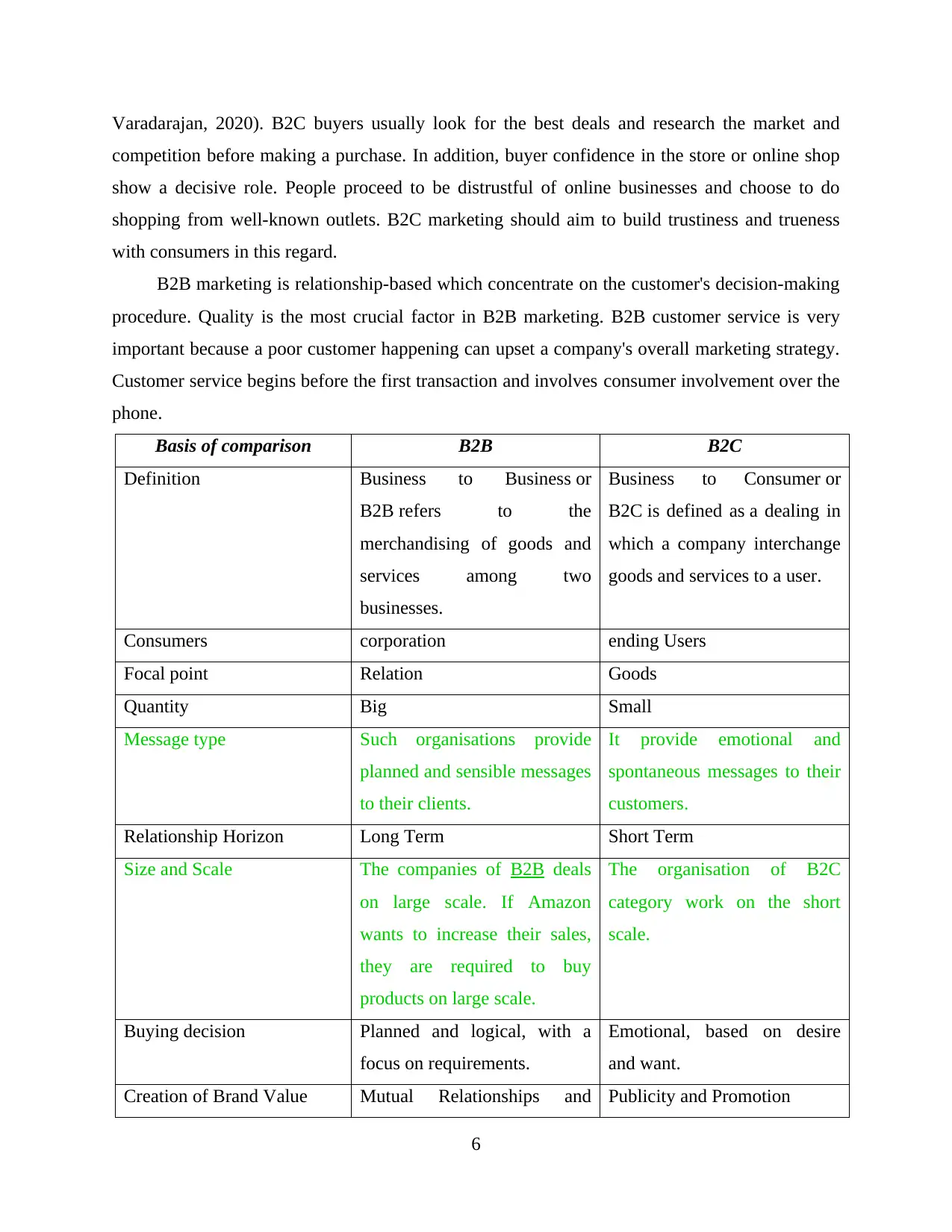
Varadarajan, 2020). B2C buyers usually look for the best deals and research the market and
competition before making a purchase. In addition, buyer confidence in the store or online shop
show a decisive role. People proceed to be distrustful of online businesses and choose to do
shopping from well-known outlets. B2C marketing should aim to build trustiness and trueness
with consumers in this regard.
B2B marketing is relationship-based which concentrate on the customer's decision-making
procedure. Quality is the most crucial factor in B2B marketing. B2B customer service is very
important because a poor customer happening can upset a company's overall marketing strategy.
Customer service begins before the first transaction and involves consumer involvement over the
phone.
Basis of comparison B2B B2C
Definition Business to Business or
B2B refers to the
merchandising of goods and
services among two
businesses.
Business to Consumer or
B2C is defined as a dealing in
which a company interchange
goods and services to a user.
Consumers corporation ending Users
Focal point Relation Goods
Quantity Big Small
Message type Such organisations provide
planned and sensible messages
to their clients.
It provide emotional and
spontaneous messages to their
customers.
Relationship Horizon Long Term Short Term
Size and Scale The companies of B2B deals
on large scale. If Amazon
wants to increase their sales,
they are required to buy
products on large scale.
The organisation of B2C
category work on the short
scale.
Buying decision Planned and logical, with a
focus on requirements.
Emotional, based on desire
and want.
Creation of Brand Value Mutual Relationships and Publicity and Promotion
6
competition before making a purchase. In addition, buyer confidence in the store or online shop
show a decisive role. People proceed to be distrustful of online businesses and choose to do
shopping from well-known outlets. B2C marketing should aim to build trustiness and trueness
with consumers in this regard.
B2B marketing is relationship-based which concentrate on the customer's decision-making
procedure. Quality is the most crucial factor in B2B marketing. B2B customer service is very
important because a poor customer happening can upset a company's overall marketing strategy.
Customer service begins before the first transaction and involves consumer involvement over the
phone.
Basis of comparison B2B B2C
Definition Business to Business or
B2B refers to the
merchandising of goods and
services among two
businesses.
Business to Consumer or
B2C is defined as a dealing in
which a company interchange
goods and services to a user.
Consumers corporation ending Users
Focal point Relation Goods
Quantity Big Small
Message type Such organisations provide
planned and sensible messages
to their clients.
It provide emotional and
spontaneous messages to their
customers.
Relationship Horizon Long Term Short Term
Size and Scale The companies of B2B deals
on large scale. If Amazon
wants to increase their sales,
they are required to buy
products on large scale.
The organisation of B2C
category work on the short
scale.
Buying decision Planned and logical, with a
focus on requirements.
Emotional, based on desire
and want.
Creation of Brand Value Mutual Relationships and Publicity and Promotion
6
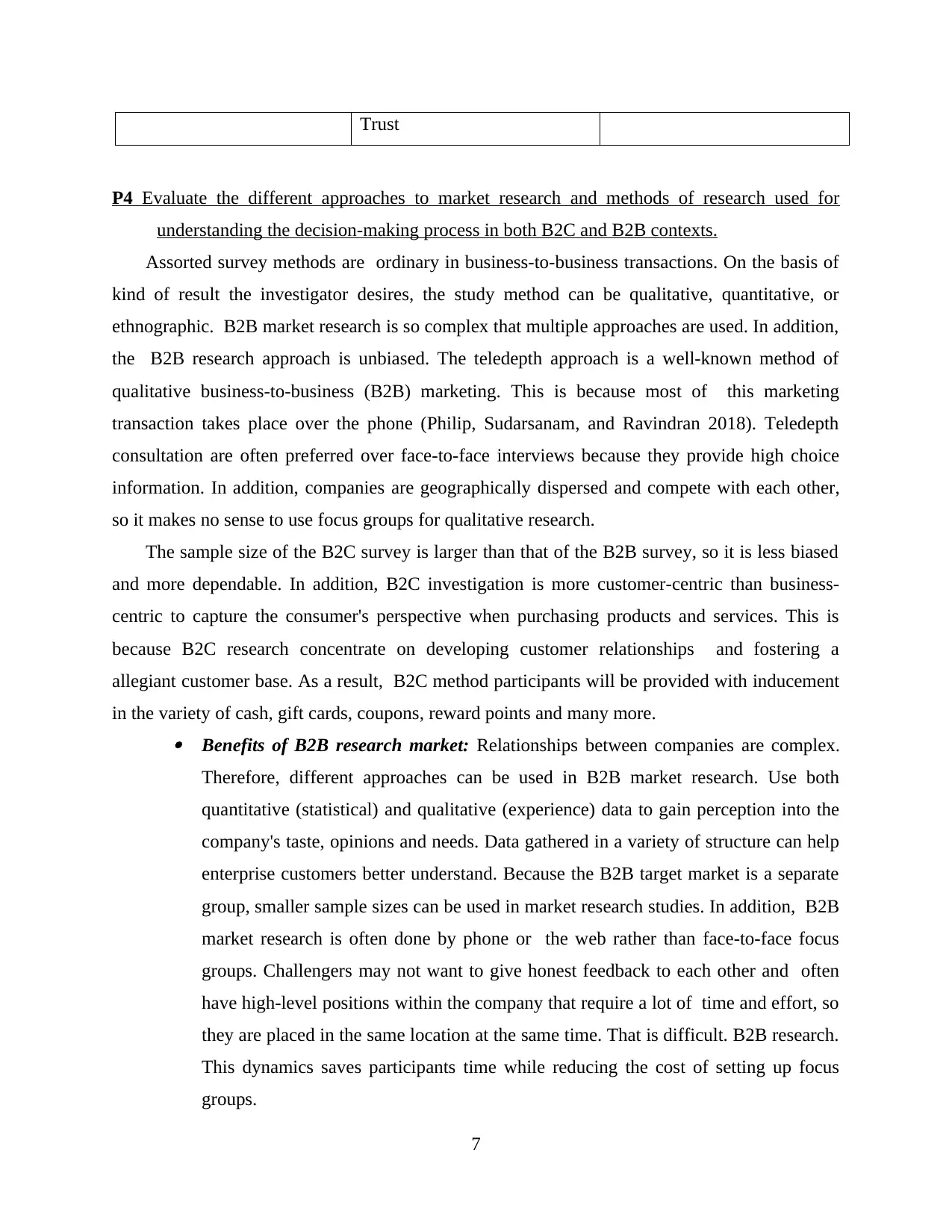
Trust
P4 Evaluate the different approaches to market research and methods of research used for
understanding the decision-making process in both B2C and B2B contexts.
Assorted survey methods are ordinary in business-to-business transactions. On the basis of
kind of result the investigator desires, the study method can be qualitative, quantitative, or
ethnographic. B2B market research is so complex that multiple approaches are used. In addition,
the B2B research approach is unbiased. The teledepth approach is a well-known method of
qualitative business-to-business (B2B) marketing. This is because most of this marketing
transaction takes place over the phone (Philip, Sudarsanam, and Ravindran 2018). Teledepth
consultation are often preferred over face-to-face interviews because they provide high choice
information. In addition, companies are geographically dispersed and compete with each other,
so it makes no sense to use focus groups for qualitative research.
The sample size of the B2C survey is larger than that of the B2B survey, so it is less biased
and more dependable. In addition, B2C investigation is more customer-centric than business-
centric to capture the consumer's perspective when purchasing products and services. This is
because B2C research concentrate on developing customer relationships and fostering a
allegiant customer base. As a result, B2C method participants will be provided with inducement
in the variety of cash, gift cards, coupons, reward points and many more.
Benefits of B2B research market: Relationships between companies are complex.
Therefore, different approaches can be used in B2B market research. Use both
quantitative (statistical) and qualitative (experience) data to gain perception into the
company's taste, opinions and needs. Data gathered in a variety of structure can help
enterprise customers better understand. Because the B2B target market is a separate
group, smaller sample sizes can be used in market research studies. In addition, B2B
market research is often done by phone or the web rather than face-to-face focus
groups. Challengers may not want to give honest feedback to each other and often
have high-level positions within the company that require a lot of time and effort, so
they are placed in the same location at the same time. That is difficult. B2B research.
This dynamics saves participants time while reducing the cost of setting up focus
groups.
7
P4 Evaluate the different approaches to market research and methods of research used for
understanding the decision-making process in both B2C and B2B contexts.
Assorted survey methods are ordinary in business-to-business transactions. On the basis of
kind of result the investigator desires, the study method can be qualitative, quantitative, or
ethnographic. B2B market research is so complex that multiple approaches are used. In addition,
the B2B research approach is unbiased. The teledepth approach is a well-known method of
qualitative business-to-business (B2B) marketing. This is because most of this marketing
transaction takes place over the phone (Philip, Sudarsanam, and Ravindran 2018). Teledepth
consultation are often preferred over face-to-face interviews because they provide high choice
information. In addition, companies are geographically dispersed and compete with each other,
so it makes no sense to use focus groups for qualitative research.
The sample size of the B2C survey is larger than that of the B2B survey, so it is less biased
and more dependable. In addition, B2C investigation is more customer-centric than business-
centric to capture the consumer's perspective when purchasing products and services. This is
because B2C research concentrate on developing customer relationships and fostering a
allegiant customer base. As a result, B2C method participants will be provided with inducement
in the variety of cash, gift cards, coupons, reward points and many more.
Benefits of B2B research market: Relationships between companies are complex.
Therefore, different approaches can be used in B2B market research. Use both
quantitative (statistical) and qualitative (experience) data to gain perception into the
company's taste, opinions and needs. Data gathered in a variety of structure can help
enterprise customers better understand. Because the B2B target market is a separate
group, smaller sample sizes can be used in market research studies. In addition, B2B
market research is often done by phone or the web rather than face-to-face focus
groups. Challengers may not want to give honest feedback to each other and often
have high-level positions within the company that require a lot of time and effort, so
they are placed in the same location at the same time. That is difficult. B2B research.
This dynamics saves participants time while reducing the cost of setting up focus
groups.
7
⊘ This is a preview!⊘
Do you want full access?
Subscribe today to unlock all pages.

Trusted by 1+ million students worldwide
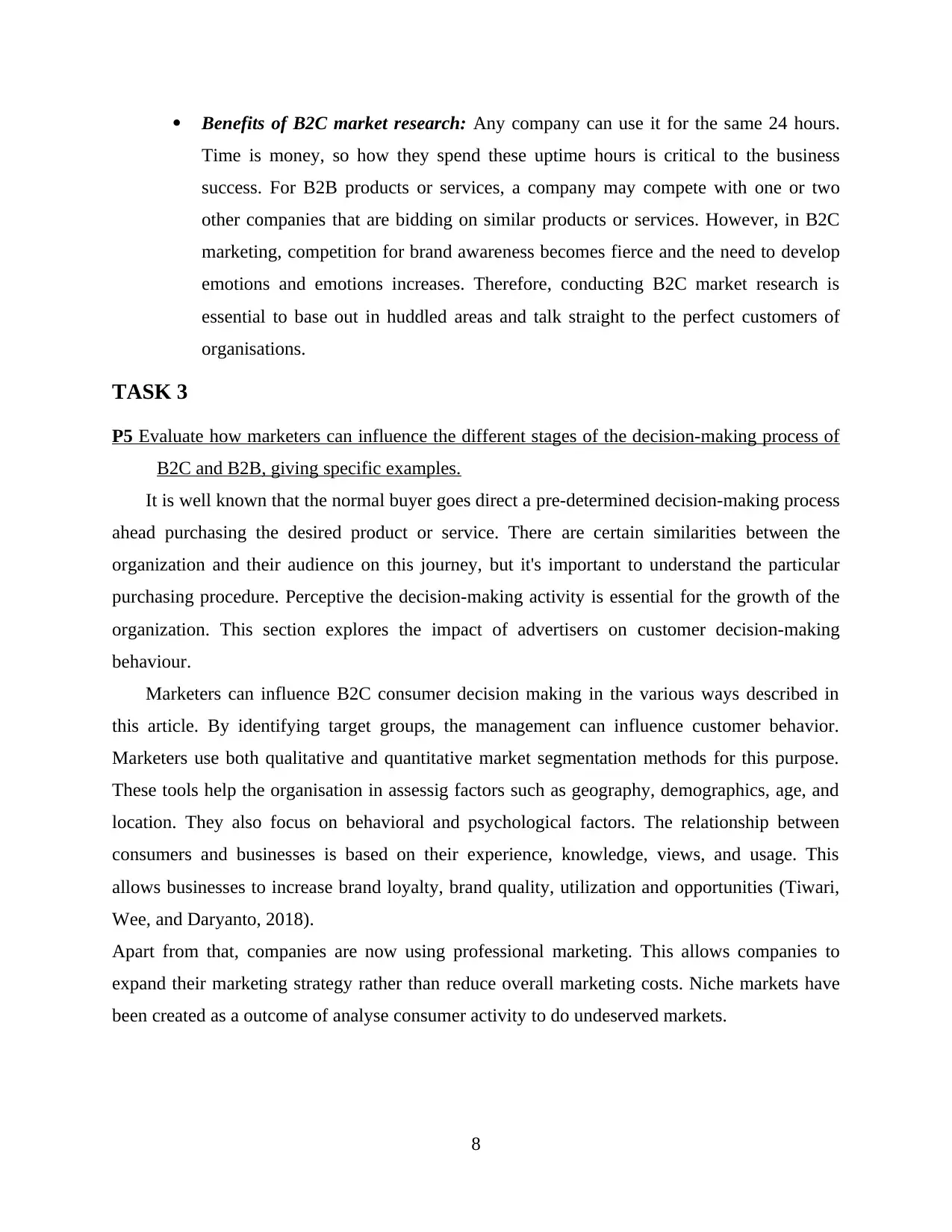
Benefits of B2C market research: Any company can use it for the same 24 hours.
Time is money, so how they spend these uptime hours is critical to the business
success. For B2B products or services, a company may compete with one or two
other companies that are bidding on similar products or services. However, in B2C
marketing, competition for brand awareness becomes fierce and the need to develop
emotions and emotions increases. Therefore, conducting B2C market research is
essential to base out in huddled areas and talk straight to the perfect customers of
organisations.
TASK 3
P5 Evaluate how marketers can influence the different stages of the decision-making process of
B2C and B2B, giving specific examples.
It is well known that the normal buyer goes direct a pre-determined decision-making process
ahead purchasing the desired product or service. There are certain similarities between the
organization and their audience on this journey, but it's important to understand the particular
purchasing procedure. Perceptive the decision-making activity is essential for the growth of the
organization. This section explores the impact of advertisers on customer decision-making
behaviour.
Marketers can influence B2C consumer decision making in the various ways described in
this article. By identifying target groups, the management can influence customer behavior.
Marketers use both qualitative and quantitative market segmentation methods for this purpose.
These tools help the organisation in assessig factors such as geography, demographics, age, and
location. They also focus on behavioral and psychological factors. The relationship between
consumers and businesses is based on their experience, knowledge, views, and usage. This
allows businesses to increase brand loyalty, brand quality, utilization and opportunities (Tiwari,
Wee, and Daryanto, 2018).
Apart from that, companies are now using professional marketing. This allows companies to
expand their marketing strategy rather than reduce overall marketing costs. Niche markets have
been created as a outcome of analyse consumer activity to do undeserved markets.
8
Time is money, so how they spend these uptime hours is critical to the business
success. For B2B products or services, a company may compete with one or two
other companies that are bidding on similar products or services. However, in B2C
marketing, competition for brand awareness becomes fierce and the need to develop
emotions and emotions increases. Therefore, conducting B2C market research is
essential to base out in huddled areas and talk straight to the perfect customers of
organisations.
TASK 3
P5 Evaluate how marketers can influence the different stages of the decision-making process of
B2C and B2B, giving specific examples.
It is well known that the normal buyer goes direct a pre-determined decision-making process
ahead purchasing the desired product or service. There are certain similarities between the
organization and their audience on this journey, but it's important to understand the particular
purchasing procedure. Perceptive the decision-making activity is essential for the growth of the
organization. This section explores the impact of advertisers on customer decision-making
behaviour.
Marketers can influence B2C consumer decision making in the various ways described in
this article. By identifying target groups, the management can influence customer behavior.
Marketers use both qualitative and quantitative market segmentation methods for this purpose.
These tools help the organisation in assessig factors such as geography, demographics, age, and
location. They also focus on behavioral and psychological factors. The relationship between
consumers and businesses is based on their experience, knowledge, views, and usage. This
allows businesses to increase brand loyalty, brand quality, utilization and opportunities (Tiwari,
Wee, and Daryanto, 2018).
Apart from that, companies are now using professional marketing. This allows companies to
expand their marketing strategy rather than reduce overall marketing costs. Niche markets have
been created as a outcome of analyse consumer activity to do undeserved markets.
8
Paraphrase This Document
Need a fresh take? Get an instant paraphrase of this document with our AI Paraphraser

The skills of marketers can affect the decision-making procedure of B2B consumers using the
various methods described here. The organisation’s decision is influenced by the changing
trading environment. In today's world, business is done online, not offline. Seller attitudes and
sophistication have steadily improved over time. Customers can now return or exchange their
purchases. On the other hand, door-to-door sales services help businesses influence consumer
behavior (Uner, Guven, Cavusgil2020). In addition, technological advances have boosted the
growth of growing industries. By using advanced application of technology in the
manufacturing of products and services, the organisation can improve efficiency and expand the
market.
CONCLUSION
From the above report, it has been concluded that the consumers are the most important part
of each and every organisation as it help the business organisation in generating revenue and also
leads to the long term stability of business organisation. It is necessary for business to track their
needs and demands along with taking the feedbacks for the future success and growth of
organisation. Customers follow a well planned procedure while making decision of buying any
product or services. In Business to Consumer transactions, the customers are in direct contact
with the business. Hence, it is consider as the best opportunity for the business organisation to
develop an effective relationship with them as it leads to the improvement in profitability and
productivity of organisation. Marketers of organisation are responsible for influencing the
customers to buy the particular products and services in order to making sales.
9
various methods described here. The organisation’s decision is influenced by the changing
trading environment. In today's world, business is done online, not offline. Seller attitudes and
sophistication have steadily improved over time. Customers can now return or exchange their
purchases. On the other hand, door-to-door sales services help businesses influence consumer
behavior (Uner, Guven, Cavusgil2020). In addition, technological advances have boosted the
growth of growing industries. By using advanced application of technology in the
manufacturing of products and services, the organisation can improve efficiency and expand the
market.
CONCLUSION
From the above report, it has been concluded that the consumers are the most important part
of each and every organisation as it help the business organisation in generating revenue and also
leads to the long term stability of business organisation. It is necessary for business to track their
needs and demands along with taking the feedbacks for the future success and growth of
organisation. Customers follow a well planned procedure while making decision of buying any
product or services. In Business to Consumer transactions, the customers are in direct contact
with the business. Hence, it is consider as the best opportunity for the business organisation to
develop an effective relationship with them as it leads to the improvement in profitability and
productivity of organisation. Marketers of organisation are responsible for influencing the
customers to buy the particular products and services in order to making sales.
9
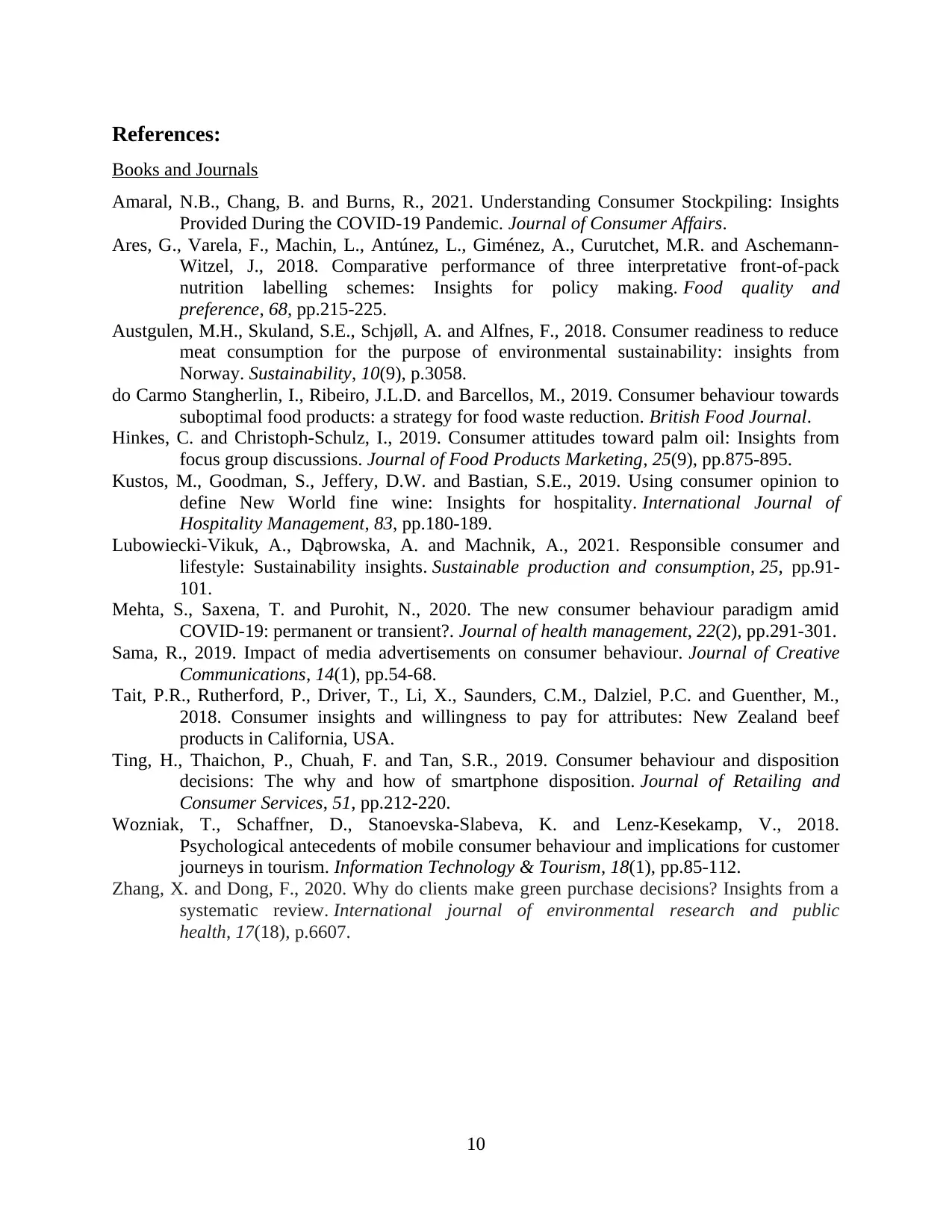
References:
Books and Journals
Amaral, N.B., Chang, B. and Burns, R., 2021. Understanding Consumer Stockpiling: Insights
Provided During the COVID‐19 Pandemic. Journal of Consumer Affairs.
Ares, G., Varela, F., Machin, L., Antúnez, L., Giménez, A., Curutchet, M.R. and Aschemann-
Witzel, J., 2018. Comparative performance of three interpretative front-of-pack
nutrition labelling schemes: Insights for policy making. Food quality and
preference, 68, pp.215-225.
Austgulen, M.H., Skuland, S.E., Schjøll, A. and Alfnes, F., 2018. Consumer readiness to reduce
meat consumption for the purpose of environmental sustainability: insights from
Norway. Sustainability, 10(9), p.3058.
do Carmo Stangherlin, I., Ribeiro, J.L.D. and Barcellos, M., 2019. Consumer behaviour towards
suboptimal food products: a strategy for food waste reduction. British Food Journal.
Hinkes, C. and Christoph-Schulz, I., 2019. Consumer attitudes toward palm oil: Insights from
focus group discussions. Journal of Food Products Marketing, 25(9), pp.875-895.
Kustos, M., Goodman, S., Jeffery, D.W. and Bastian, S.E., 2019. Using consumer opinion to
define New World fine wine: Insights for hospitality. International Journal of
Hospitality Management, 83, pp.180-189.
Lubowiecki-Vikuk, A., Dąbrowska, A. and Machnik, A., 2021. Responsible consumer and
lifestyle: Sustainability insights. Sustainable production and consumption, 25, pp.91-
101.
Mehta, S., Saxena, T. and Purohit, N., 2020. The new consumer behaviour paradigm amid
COVID-19: permanent or transient?. Journal of health management, 22(2), pp.291-301.
Sama, R., 2019. Impact of media advertisements on consumer behaviour. Journal of Creative
Communications, 14(1), pp.54-68.
Tait, P.R., Rutherford, P., Driver, T., Li, X., Saunders, C.M., Dalziel, P.C. and Guenther, M.,
2018. Consumer insights and willingness to pay for attributes: New Zealand beef
products in California, USA.
Ting, H., Thaichon, P., Chuah, F. and Tan, S.R., 2019. Consumer behaviour and disposition
decisions: The why and how of smartphone disposition. Journal of Retailing and
Consumer Services, 51, pp.212-220.
Wozniak, T., Schaffner, D., Stanoevska-Slabeva, K. and Lenz-Kesekamp, V., 2018.
Psychological antecedents of mobile consumer behaviour and implications for customer
journeys in tourism. Information Technology & Tourism, 18(1), pp.85-112.
Zhang, X. and Dong, F., 2020. Why do clients make green purchase decisions? Insights from a
systematic review. International journal of environmental research and public
health, 17(18), p.6607.
10
Books and Journals
Amaral, N.B., Chang, B. and Burns, R., 2021. Understanding Consumer Stockpiling: Insights
Provided During the COVID‐19 Pandemic. Journal of Consumer Affairs.
Ares, G., Varela, F., Machin, L., Antúnez, L., Giménez, A., Curutchet, M.R. and Aschemann-
Witzel, J., 2018. Comparative performance of three interpretative front-of-pack
nutrition labelling schemes: Insights for policy making. Food quality and
preference, 68, pp.215-225.
Austgulen, M.H., Skuland, S.E., Schjøll, A. and Alfnes, F., 2018. Consumer readiness to reduce
meat consumption for the purpose of environmental sustainability: insights from
Norway. Sustainability, 10(9), p.3058.
do Carmo Stangherlin, I., Ribeiro, J.L.D. and Barcellos, M., 2019. Consumer behaviour towards
suboptimal food products: a strategy for food waste reduction. British Food Journal.
Hinkes, C. and Christoph-Schulz, I., 2019. Consumer attitudes toward palm oil: Insights from
focus group discussions. Journal of Food Products Marketing, 25(9), pp.875-895.
Kustos, M., Goodman, S., Jeffery, D.W. and Bastian, S.E., 2019. Using consumer opinion to
define New World fine wine: Insights for hospitality. International Journal of
Hospitality Management, 83, pp.180-189.
Lubowiecki-Vikuk, A., Dąbrowska, A. and Machnik, A., 2021. Responsible consumer and
lifestyle: Sustainability insights. Sustainable production and consumption, 25, pp.91-
101.
Mehta, S., Saxena, T. and Purohit, N., 2020. The new consumer behaviour paradigm amid
COVID-19: permanent or transient?. Journal of health management, 22(2), pp.291-301.
Sama, R., 2019. Impact of media advertisements on consumer behaviour. Journal of Creative
Communications, 14(1), pp.54-68.
Tait, P.R., Rutherford, P., Driver, T., Li, X., Saunders, C.M., Dalziel, P.C. and Guenther, M.,
2018. Consumer insights and willingness to pay for attributes: New Zealand beef
products in California, USA.
Ting, H., Thaichon, P., Chuah, F. and Tan, S.R., 2019. Consumer behaviour and disposition
decisions: The why and how of smartphone disposition. Journal of Retailing and
Consumer Services, 51, pp.212-220.
Wozniak, T., Schaffner, D., Stanoevska-Slabeva, K. and Lenz-Kesekamp, V., 2018.
Psychological antecedents of mobile consumer behaviour and implications for customer
journeys in tourism. Information Technology & Tourism, 18(1), pp.85-112.
Zhang, X. and Dong, F., 2020. Why do clients make green purchase decisions? Insights from a
systematic review. International journal of environmental research and public
health, 17(18), p.6607.
10
⊘ This is a preview!⊘
Do you want full access?
Subscribe today to unlock all pages.

Trusted by 1+ million students worldwide
1 out of 12
Related Documents
Your All-in-One AI-Powered Toolkit for Academic Success.
+13062052269
info@desklib.com
Available 24*7 on WhatsApp / Email
![[object Object]](/_next/static/media/star-bottom.7253800d.svg)
Unlock your academic potential
Copyright © 2020–2025 A2Z Services. All Rights Reserved. Developed and managed by ZUCOL.





